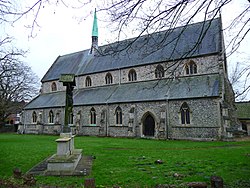| Holy Trinity Church, Winchester | |
|---|---|
 | |
 | |
| OS grid reference | SU 48357 29722 |
| Address | Upper Brook Street, Winchester |
| Country | England |
| Denomination | Church of England |
| Churchmanship | Anglo-Catholic |
| Website | Official website |
| History | |
| Consecrated | July 1854 |
| Architecture | |
| Architect(s) | Henry Woodyer |
| Style | "Early Decorated" [1] |
| Years built | 1852-54 |
| Construction cost | £4,780 |
| Administration | |
| Diocese | Winchester |
| Deanery | Winchester |
| Clergy | |
| Bishop(s) | The Rt Revd Norman Banks ( AEO ) |
| Priest(s) | The Revd Jamie Franklin |
| Laity | |
| Churchwarden(s) | Kathy Mabey |
Holy Trinity Church, Winchester is a Church of England parish church in Winchester, in Hampshire, England.